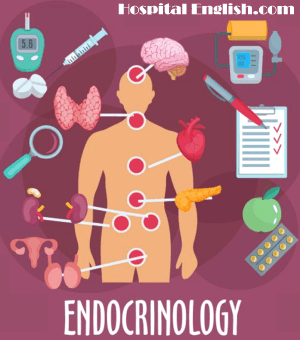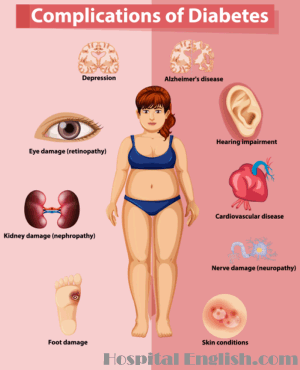Disease State Directors: these articles prepare students to explain about the disease itself and also be able to relay the important information that patients should know.
Diabetes: Type 1
Pre-Reading Vocabulary:
amputation
autoimmune disease
blood vessels
cells
circulatory
complications
damage
dehydration
detection
diabetes
diagnosis
function
glucose
hyperglycemia
infection
insulin
insurance
ketone bodies
kidney
nerve
nutrients
pancreas
retinopathy
starve
subtle
symptom
toxin
urine

Listen to the 2 articles:
Listen and try to answer the discussion questions or take the quiz. You can also listen and read along with the scripts below.
Listen to the audio file and then you may advance to the discussion or comprehension questions. Listen as many times as you need to answer the questions. (You can read the full articles below.)
Listen to the audio files and then you may advance to the discussion or comprehension questions. Listen as many times as you need to answer the questions. (You can read the full articles below.)
Follow-ups:
- After completing the test exercises, try the speaking activity with the conversation questions.
- Roleplay a nurse/patient dialog where the nurse explains about the disease to a new diabetes patient or the patient's guardian.
For self study: Verify you understand the key words for the articles. Then try to answer the following conversation questions, speaking out loud.
Discussion Questions:
- What are the main features of type 1 diabetes?
- What role does insulin play in the body?
- What are some of the problems with uncontrolled blood sugar?
- What information is important to tell the patient?
Reading Article 1: read the article and then answer the questions.
Article 1: Overview of Type 1 Diabetes ![]()
Type 1 Diabetes is an autoimmune disease. It is thought to be caused by an environmental trigger (possibly a virus or toxin but doctors aren't sure.) This trigger causes the immune system to attack beta cells in the pancreas. Beta cells produce insulin, and after the immune system damages enough beta cells, the body cannot produce sufficient insulin supplies.
Type 1 Diabetes can present at any age but usually presents before the age of 20 and the symptoms are subtle. Some of the more common symptoms are frequent urination, unexplainable weight loss, hunger after meals, fatigue, blurred vision and dehydration complications. Filtering of glucose by the kidneys results in large amounts of water loss causing dehydration. Dehydration associated with hyperglycemia (high blood sugar) causes increased thirst and dry mouth, as well as increased skin, urinary tract, and vaginal infections.
Diagnosis is usually made by detection of abnormalities in blood glucose levels and by glucose or ketone bodies in the urine. Because of the high risks associated with hyperglycemia and the difficulties associated with therapy, it is suggested patients visit a diabetes counselor for regular monitoring, counseling and follow-up.

Comprehension Questions:
1.What type of disease is type 1 diabetes?
2.Why can't the body produce insulin in type 1 diabetes?
3.What are some common symptoms of type 1 diabetes?
4.What are the problems associated with dehydration?
5.How is diabetes usually diagnosed?
Reading Article 2: read the patient information article and then answer the questions.
Article 2: Type 1 Diabetes Information for the Patient ![]()
Type 1 diabetes is a disease that destroys the insulin-producing cells in the pancreas. It is an autoimmune disease, which means the body's immune system is attacking itself. By attacking the insulin-producing cells, these cells are damaged and cannot produce enough insulin to supply the body.
In the body, insulin helps move sugar and other nutrients from the bloodstream into the cells of the body. Cells use sugar as energy for all of their functions. When the body destroys the beta cells nutrients, especially sugar, are not transported into the cells. The cells of the body starve and the blood sugar level rises. High blood sugar can cause dehydration, weight loss, and irreversible damage to small blood vessels in the kidney, eyes and heart.
When blood sugar is not controlled, patients are in danger of developing several serious diseases and complications.
- retinopathy - a disease that affects the eyes and vision
- kidney damage - which could lead to kidney failure and heart disease
- circulatory problems
- possibly leading to nerve damage, infection, and amputation
Quality of life can be maintained by keeping blood sugar levels in target ranges. Management requires exercise, meal planning, and insulin therapy (insulin injections.) Careful monitoring of blood sugar levels, both fasting and after meals, is important. There are diabetes counselors who can help patients take control of their disease. These services are often covered by most insurance plans and can be a great benefit to patients.
Comprehension Questions:
1. Why can't the body produce insulin in type one diabetes?
2. What does insulin do in the body?
3. What effects does high blood sugar have in the body?
4. What serious disease result from uncontrolled blood sugar?
5. What are some ways to manage diabetes?


End User License Agreement: You are free to download any resource from this site as an end user and MES-English.com grants you an End User License with the following restrictions: You may not redistribute, copy, modify, transfer, transmit, repackage, charge for or sell any of the materials from this site. You may use photocopies or printouts for distribution to your students. MES reserves the right to terminate or make changes to this agreement for any reason and without notice.
Copyright © 2006 - 2024 Hospital English | restrictions | privacy | about | contact
